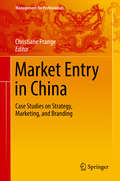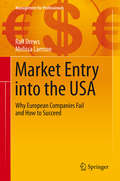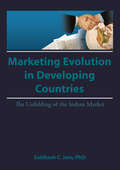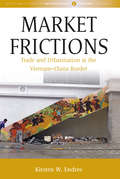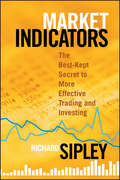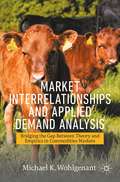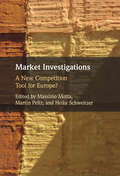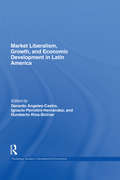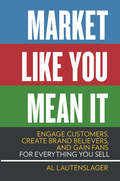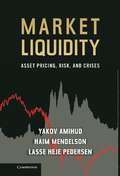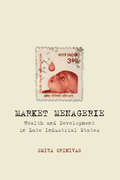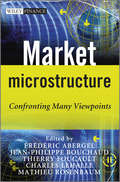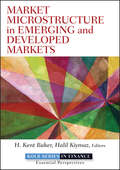- Table View
- List View
Market Entry in China
by Christiane PrangeThis book compiles brand new case studies on the intricacies and market entry strategies of different companies in China. The sheer speed and scope of China's growth makes it unique and investment opportunities are very attractive. Despite the potential, many western companies fail in their market entry strategies. This book traces the major sources of failure and uses cases to illustrate how firms can better cope with the challenging Chinese market. With a special focus on marketing, positioning, and branding, this book presents issues and solutions of both large multinationals and small niche market players.
Market Entry into the USA
by Ralf Drews Melissa LamsonThis book connects a buying psychology driven by American beliefs and values with a company's go-to market strategy, the goal being to sensitize readers to how the cultural values of a particular country or region can impact the business environment. The book also addresses the reasons behind these differences and therefore begins with a detailed cultural comparison of the United States and Europe, and assessments of how these characteristics impact their respective markets and customer behavior differently. Another aspect that sets this book apart is that it argues for sound decision-making processes as the first priority in any international business strategy. Readers are provided detailed insights into the variables a European company needs to understand before it makes its "go/no-go" decision, along with the tools needed to evaluate the probability of success and the risks of going to market. Once a company decides to enter the US market, the book then offers a highly customer-centric approach to developing and executing an effective market strategy.
Market Evolution in Developing Countries: The Unfolding of the Indian Market
by Erdener Kaynak Subhash C JainMarkets in Third World countries are growing rapidly and in the next several decades will offer tremendous business opportunities. Firms aspiring to be a part of this growth must establish their presence in these markets today or lose the opportunity forever. Market Evolution in Developing Countries illustrates how these markets are likely to evolve as mass markets along the lines of advanced nations and examines conditions that affect this evolution. The author develops a model of market evolution based on a general overview of all evolving markets which is then applied and thoroughly discussed with reference to India, a burgeoning market of some 200 million people. Through a conceptual framework of market evolution, this groundbreaking book describes how markets at various stages of development offer different opportunities and thus require different strategies for success. Author Jain outlines strategic moves that American businesses may make to capitalize on such opportunities. He also covers information on policy initiatives developing countries themselves can take to help in the smooth evolution of their markets and specific steps leaders of these countries may take to enable greater growth in their markets.While Market Evolution in Developing Countries uses India as a case study, the strategies for doing business successfully there are equally relevant and easily adaptable for use in other developing countries. Some of the many topics addressed include India’s government and politics, corporate environment, international competitiveness, and changing market behavior, as well as U.S. direct investment in India, Indo-U.S. business relations, and political-legal differences between the U.S. and India. This informative guide also contains a brief historical overview of India, a profile of a middle-class Indian family, and a handy section of cultural tips and other advice for business persons traveling to India to help them cope with business negotiations there. In a readable style, this book provides comprehensive information for all business professionals interested in the vast opportunities available in many Third World countries. Market Evolution in Developing Countries is ideal for international business executives and consultants who wish to review opportunities in these countries and learn how to take advantage of them effectively. It is a basic resource on economic opportunities in developing countries.
Market Expansion and Social Dumping in Europe (Routledge Advances in European Politics)
by Magdalena BernaciakThe term ‘social dumping’ regularly appears in public debates and in policymaking circles. However, due to its ambiguity it is used in a manner that is convenient for individual discourse participants, thus opening the door for misconceptions and ill-grounded accusations. This book systematically examines social dumping in the context of the European integration process. It defines social dumping as the practice, undertaken by self-interested market participants, of undermining or evading existing social regulations with the aim of gaining a competitive advantage. It also shows how the two major EU integration projects the creation of the Internal Market, and EU enlargement to the east and to the south have provided market actors with new incentives and opportunities to contest existing social ‘constraints’. The empirical chapters examine social dumping practices accompanying labour migration, employee posting and cross-border investment distribution. In addition, they outline the process of formation of social standards and trace initiatives at EU and national levels that contribute to the spread of social dumping in Europe. This book will be of interest to scholars and students of employment relations, EU studies, international political economy, globalisation studies, welfare studies, social policy and migration studies.
Market Failures
by Bharat N. Anand Tarun Khanna Jan W. RivkinExamines the role of transaction costs in impeding the functioning of markets and shows how the concept of transaction costs sheds light on a broad range of issues in strategy.
Market Farming Success: The Business of Growing and Selling Local Food, 2nd Editon
by Lynn ByczynskiAn insider's guide to market gardening and farming for those in the business of growing and selling food, flowers, herbs, or plants.Market Farming Success identifies the key areas that usually trip up beginners—and shows how to avoid those obstacles. This book will help the aspiring or beginning farmer advance quickly and confidently through the inevitable learning curve of starting a new business.Written by the editor of Growing for Market, a respected trade journal for market farmers, Market Farming Success condenses decades of growing experience from every part of the United States and Canada. It focuses on the factors that are common to market gardeners everywhere and offers professional advice that includes:• How much you'll need to spend to start a market farming business;• How much you can expect to earn;• Which crops bring in the most money—and whether you should grow them;• The essential tools and equipment you will need;• The best places to sell your products;• How to keep records to maximize profits and minimize taxes;• Tricks of the trade that will make you more efficient in the greenhouse, field, and market.This new Chelsea Green edition of a 2006 classic is greatly updated and expanded, and includes full-color photos, charts, and graphs, plus many inspiring and instructive profiles of successful market-farming pioneers.
Market Frictions: Trade and Urbanization at the Vietnam-China Border (Max Planck Studies in Anthropology and Economy #5)
by Kirsten W. EndresBased on ethnographic research conducted during several years, Market Frictions examines the tensions and frictions that emerge from the interaction of global market forces, urban planning policies, and small-scale trading activities in the Vietnamese border city of Lào Cai. Here, it is revealed how small-scale traders and market vendors experience the marketplace, reflect upon their trading activities, and negotiate current state policies and regulations. It shows how “traditional” Vietnamese marketplaces have continually been reshaped and adapted to meet the changing political-economic circumstances and civilizational ideals of the time.
Market Indicators: The Best-Kept Secret to More Effective Trading and Investing (Bloomberg Financial #38)
by Richard SipleyA smart trader needs to know what other traders are thinking and doing. Professional traders and investors use a wide range of indicators—some well-known, some not so well-known—to gauge the state of the market. Market Indicators introduces the many key indicators used by professional traders and investors every day. Having stood the test of time, these indicators will alert the trader to market situations that offer the best chance to trade profitably. Richard Sipley is a portfolio manager for Boston Private Bank and Trust Company, responsible for trading millions of dollars of assets. Sipley uses these indicators every day in his trading and investing, and he draws on that experience to explain what they are, how they work, and how to use them.
Market Integration Through Data Protection
by Mario Viola de Azevedo CunhaIn the context of the continuous advance of information technologies and biomedicine, and of the creation of economic blocs, this work analyzes the role that data protection plays in the integration of markets. It puts special emphasis on financial and insurance services. Further, it identifies the differences in the data protection systems of EU member states and examines the development of common standards and principles of data protection that could help build a data protection model for Mercosur. Divided into four parts, the book starts out with a discussion of the evolution of the right to privacy, focusing on the last few decades, and taking into account the development of new technologies. The second part discusses the interaction between data protection and specific industries that serve as case studies: insurance, banking and credit reporting. The focus of this part is on generalization and discrimination, adverse selection and the processing of sensitive and genetic data. The third part of the book presents an analysis of the legislation of three EU Member States (France, Italy and UK). Specific elements of analysis that are compared are the concepts of personal and anonymous data, data protection principles, the role of the data protection authorities, the role of the data protection officer, data subjects' rights, the processing of sensitive data, the processing of genetic data and the experience of the case studies in processing data. The book concludes with the proposal of a model for data protection that could be adopted by Mercosur, taking into account the different levels of data protection that exist in its member states.
Market Interrelationships and Applied Demand Analysis: Bridging the Gap Between Theory and Empirics in Commodities Markets (Palgrave Studies in Agricultural Economics and Food Policy)
by Michael K. WohlgenantThis textbook addresses the core issues facing economists concerning price determination in commodity markets, especially food and agricultural commodities. This book hones in on the conceptual basis of the various relationships, with special emphasis on market interrelationships, both horizontally and vertically. This book covers key concepts such as consumer demand theory; quality, heterogeneous goods, and cross section demand; derived demand, marketing margins, and relationship between output and raw material prices; retail-to-farm demand linkages, imperfect competition, and short-run price determination; dynamic consumer demand; and dynamic models of the firm.What makes this textbook of particular use to students is its focus on bridging the gap between theory and empirical analysis. Going from theory to empirics requires that we have data—time series or cross section—that match the theoretical constructs. Often the data match is not perfect, either by definition or how the data are computed. In addition to problems of matching data with theoretical constructs, students and researchers need to know how to specify, estimate, and interpret results within the context of imperfect and often incomplete data. This textbook uses several data sets to illustrate how one might address problems in real-world settings. Furthermore, with exercises at the end of each chapter, students are able to test themselves on their ability to bring theory to life.
Market Investigations: A New Competition Tool for Europe?
by Martin Peitz Massimo Motta Heike SchweitzerIn many economic sectors – the digital industries being first and foremost – the market power of dominant firms has been steadily increasing and is rarely challenged by competitors. Existing competition laws and regulations have been unable to make markets more contestable. The book argues that a new competition tool is needed: market investigations. This tool allows authorities to intervene in markets which do not function as they should, due to market features such as network effects, scale economies, switching costs, and behavioural biases. The book explains the role of market investigations, assesses their use in the few jurisdictions where they exist, and discusses how they should be designed. In so doing, it provides an invaluable and timely instrument to both practitioners and academics.
Market Justice
by Brent Z. KaupMarket Justice explores the challenges for the new global left as it seeks to construct alternative means of societal organization. Focusing on Bolivia, Brent Z. Kaup examines a testing ground of neoliberal and counter-neoliberal policies and an exemplar of bottom-up globalization. Kaup argues that radical shifts towards and away from free market economic trajectories are not merely shaped by battles between transnational actors and local populations, but also by conflicts between competing domestic elites and the ability of the oppressed to overcome traditional class divides. Further, the author asserts that struggles against free markets are not evidence of opposition to globalization or transnational corporations. They should instead be understood as struggles over the forms of global integration and who benefits from them.
Market Liberalism, Growth, and Economic Development in Latin America (Routledge Studies In Development Economics Ser. #89)
by Gerardo Angeles-Castro Ignacio Perrotini-Hernández Humberto Ríos-BolívarThe principal themes pursued in this book emerge from the great transformation that the Latin American and the Caribbean economies experienced in the aftermath of both the foreign debt crisis of 1982 and the macroeconomic stabilisation policies that vividly and painfully produced the so-called "lost decade" of the 1980s. Latin America implemented an economic liberalisation process during the late 1980s and the 1990s. The main policy reforms involved in that course can be summarized as privatization of state owned firms, trade openness, deregulation of the foreign direct investment (FDI) regime and fiscal discipline. Latin American countries have also embarked in regional trade agreements, the most important ones being Mercosur and the North American Free trade Agreement (NAFTA). This book compares results from the experience of North-South and South-South moulds of integration. Thus, the impacts of these policies on growth, development, technological progress, poverty and inequality are analysed. Orthodox and heterodox economic policies and theories are discussed along with relevant empirical evidence with a view to assess, on the one hand, the relative merits of the various policy reforms applied by different countries in the region, and on the other, the experience of integration into the global economy. There are thirteen chapters in this collection linked in varying ways to the series of economic reforms introduced in the region in the last decades. The book will be of interest to academics, researchers, students and policymakers interested in the study of economic development in emerging economies and in particular in Latin America.
Market Liberalizations and Emigration from Latin America (Routledge Studies in Latin American Development)
by Jon JonakinMarket Liberalizations and Emigration From Latin America provides a comprehensive analysis of the impact of the era of liberalization in Latin America, focusing in particular on labor markets and emigration from the region. Starting in 1980, liberalization in Latin America was expected to improve market functioning, efficiency, and welfare. Instead, it yielded slower growth, unexpectedly high levels of unemployment and income inequality, flat or falling wages, an increase in non-tradeable (service sector) and informal activity, and, finally, waves of emigration from Mexico, Central America, and Ecuador, among other countries. This book provides a heterodox narrative explanation of why the orthodox economic model that underwrote the standard ‘trickle-down’ account served more to obscure and obfuscate than to explain and clarify the state-of-affairs. The book investigates the impact of the global-scale liberalizations of markets for goods and physical and finance capital and the mere national-scale liberalization of regional labor markets, arguing that these asymmetric liberalizations, together, resulted in labor market failure and contributed in turn to the subsequent, undocumented migrant flow. The ultimate effect of the skewed scale of market liberalizations in Latin America disproportionately benefited capital at the expense of labor. Market Liberalizations and Emigration From Latin America will be of interest to researchers of economics and development in Latin America.
Market Like You Mean It
by Al LautenslagerConsumers are exposed to as many as 5,000 daily marketing messages via online, social media, and traditional marketing channels. Entrepreneurs will learn what it takes to get noticed by tapping into the playbooks of successful product producers including Nike, Red Bull, Steve Jobs, Dr. Dre and others.Successful marketer Al Lautenslager presents an entertaining look at what it takes to gain consumer buy-in and buzz across all marketing channels and reveals simple truths that any business can use to achieve the same, relative to their market. Led by Lautenslager, entrepreneurs learn how to zero in on their marketing goals, choose the best marketing tactics, integrate online and traditional marketing, and more. Points are illustrated through entertaining examples and case studies of little-known and well-known marketing and media phenomena such as flash mobs, Rachel Ray, Justin Bieber, and GoDaddy.com.
Market Liquidity
by Yakov Amihud Haim Mendelson Lasse Heje PedersenThis book presents the theory and evidence on the effect of market liquidity and liquidity risk on asset prices and on overall securities market performance. Illiquidity means incurring a high transaction cost, which includes a large price impact when trading and facing a long time to unload a large position. Liquidity risk is higher if a security becomes more illiquid when it needs to be traded in the future, which will raise trading cost. The book shows that higher illiquidity and greater liquidity risk reduce securities prices and raise the expected return that investors require as compensation. Aggregate market liquidity is linked to funding liquidity, which affects the provision of liquidity services. When these become constrained, there is a liquidity crisis which leads to downward price and liquidity spiral. Overall, the volume demonstrates the important role of liquidity in asset pricing.
Market Liquidity Risk
by Andria van der MerweWhat is market liquidity? How can market liquidity be priced and managed? Understanding liquidity in the marketplace is no simple task but understanding the implications in the increasing complex financial systems is important to navigating the inevitable swings that occur. Andria van der Merwe's book offers an analytic, though accessible explanation of the impact that liquidity has on the normal functioning of markets. Van der Merwe begins with a brief historical overview of trading, liquidity, and financial markets before segueing into a look at major crises and how liquidity is affected by changing market dynamics. Van der Merwe builds on insights from microstructure theory to evaluate events of liquidity crises in light of the impact they have on the normal functioning of markets. She presents a framework of liquidity adjusted pricing for fixed income and credit-related securities like credit default swaps. The book also showcases the interactions between liquidity and credit, as well as the relationship between liquidity in stable and unstable markets. To conclude, a blueprint if offered for dealing with expected market liquidity issues in asset pricing and risk management. Andria van der Merwe provides a thorough guide to the critical tools needed to navigate liquidity markets and value security pricing in the presence of market frictions and information asymmetries. This is essential reading for anyone with an interest in liquidity models, market structures, and trading mechanisms.
Market Management and Project Business Development
by Hedley SmythMarket Management and Project Business Development is a guide to the theory of marketing and selling projects in business, demonstrating how to secure and deliver value, and improve performance in profitable ways. By providing a set of key principles and guidelines to business-to-business (B2B) marketing, construction project management expert Hedley Smyth demonstrates how to use marketing and business development principles to maximise the value of a project. The book takes a step-by-step approach by dealing with each stage in a project’s lifecycle in turn, covering a range of approaches including the marketing mix, relationship marketing and its project marketing variant, entrepreneurial marketing and the service-dominant logic. This book is valuable reading for all students and specialists in project management, as well as project managers in business, management, the built environment, or indeed any industry.
Market Manipulation and The Price of Eggs: A Microhistory of Free Markets and Artificial Prices
by David RessThis Palgrave Pivot presents a microhistory of an important but little-known incident of futures trading. The case in question concerns an incident in the futures market operated by the Chicago Board of Trade (CBOT) in 1968, where an individual trader David Henner was able to set an unusually (and, ultimately unjustified) high closing price for delivery of eggs in six months. By examining the legal and economic theoretical context of this incident, the book argues that the definition of market manipulation is not straightforward, and has been complicated by a reluctance among regulators to accept the idea that ordinary market dynamics can produce a false price. Unlike most other cases of financial market manipulation, the finding here did not involve a market corner or some form of insider trading, but instead suggested that the inherent dynamics of an open outcry market could produce an unreal price. As narrative history, it offers scholars and practitioners of financial market regulation and operation a valuable way of looking at why otherwise inexplicable breaks in prices occur. This book will be valuable reading for those interested in law and economics, financial regulation, and the history of commodities and futures trading.
Market Maoists: The Communist Origins of China's Capitalist Ascent
by Jason M. KellyLong before Deng Xiaoping’s market-based reforms, commercial relationships bound the Chinese Communist Party to international capitalism and left lasting marks on China’s trade and diplomacy. China today seems caught in a contradiction: a capitalist state led by a Communist party. But as Market Maoists shows, this seeming paradox is nothing new. Since the 1930s, before the Chinese Communist Party came to power, Communist traders and diplomats have sought deals with capitalists in an effort to fuel political transformation and the restoration of Chinese power. For as long as there have been Communists in China, they have been reconciling revolutionary aspirations at home with market realities abroad. Jason Kelly unearths this hidden history of global commerce, finding that even Mao Zedong saw no fundamental conflict between trading with capitalists and chasing revolution. China’s ties to capitalism transformed under Mao but were never broken. And it was not just goods and currencies that changed hands. Sustained contact with foreign capitalists shaped the Chinese nation under Communism and left deep impressions on foreign policy. Deals demanded mutual intelligibility and cooperation. As a result, international transactions facilitated the exchange of ideas, habits, and beliefs, leaving subtle but lasting effects on the values and attitudes of individuals and institutions. Drawing from official and commercial archives around the world, including newly available internal Chinese Communist Party documents, Market Maoists recasts our understanding of China’s relationship with global capitalism, revealing how these early accommodations laid the groundwork for China’s embrace of capitalism in the 1980s and after.
Market Mediations: Semiotic Investigations on Consumers, Objects and Brands
by Benoît HeilbrunnMarket Mediations offers a fresh way to look at consumption practices, design and branding issues through analysis based on the French and European intellectual tradition. To account for this vast system of objects and brands, the book draws on the generative trajectory of meaning stemming from the structural semiotics of Greimas obedience.
Market Menagerie: Health and Development in Late Industrial States
by Smita SrinivasMarket Menagerieexamines technological advance and market regulation in the health industries of nations such as India, Brazil, South Africa, Nigeria, and China. Pharmaceutical and life science industries can reinforce economic development and industry growth, but not necessarily positive health outcomes. Yet well-crafted industrial and health policies can strengthen each other and reconcile economic and social goals. This book advocates moving beyond traditional market failure to bring together three uncommonly paired themes: the growth of industrial capabilities, the politics of health access, and the geography of production and redistribution.
Market Microstructure
by Jean-Philippe Bouchaud Charles-Albert Lehalle Thierry Foucault Mathieu Rosenbaum Frédéric AbergelThe latest cutting-edge research on market microstructureBased on the December 2010 conference on market microstructure, organized with the help of the Institut Louis Bachelier, this guide brings together the leading thinkers to discuss this important field of modern finance. It provides readers with vital insight on the origin of the well-known anomalous "stylized facts" in financial prices series, namely heavy tails, volatility, and clustering, and illustrates their impact on the organization of markets, execution costs, price impact, organization liquidity in electronic markets, and other issues raised by high-frequency trading. World-class contributors cover topics including analysis of high-frequency data, statistics of high-frequency data, market impact, and optimal trading. This is a must-have guide for practitioners and academics in quantitative finance.
Market Microstructure and Nonlinear Dynamics
by Fredj Jawadi Gilles Dufrénot Waël LouhichiThis book discusses market microstructure environment within the context of the global financial crisis In the first part, the market microstructure theory is recalled and the main microstructure models and hypotheses are discussed. The second part focuses on the main effects of the financial downturn through an examination of market microstructure dynamics. In particular, the effects of market imperfections and the limitations associated with microstructure models are discussed. Finally, the new regulations and recent developments for financial markets that aim to improve the market microstructure are discussed. Well-known experts on the subject contribute to the chapters in the book. A must-read for academic researchers, students and quantitative practitioners.
Market Microstructure in Emerging and Developed Markets
by H. Kent Baker Halil KiymazA comprehensive guide to the dynamic area of finance known as market microstructure Interest in market microstructure has grown dramatically in recent years due largely in part to the rapid transformation of the financial market environment by technology, regulation, and globalization. Looking at market transactions at the most granular level--and taking into account market structure, price discovery, information flows, transaction costs, and the trading process--market microstructure also forms the basis of high-frequency trading strategies that can help professional investors generate profits and/or execute optimal transactions.Part of the Robert W. Kolb Series in Finance, Market Microstructure skillfully puts this discipline in perspective and examines how the working processes of markets impact transaction costs, prices, quotes, volume, and trading behavior. Along the way, it offers valuable insights on how specific features of the trading process like the existence of intermediaries or the environment in which trading takes place affect the price formation process.Explore issues including market structure and design, transaction costs, information flows, and disclosureAddresses market microstructure in emerging marketsCovers the legal and regulatory issues impacting this area of financeContains contributions from both experienced financial professionals and respected academics in this fieldIf you're looking to gain a firm understanding of market microstructure, this book is the best place to start.
